What is biodiversity?
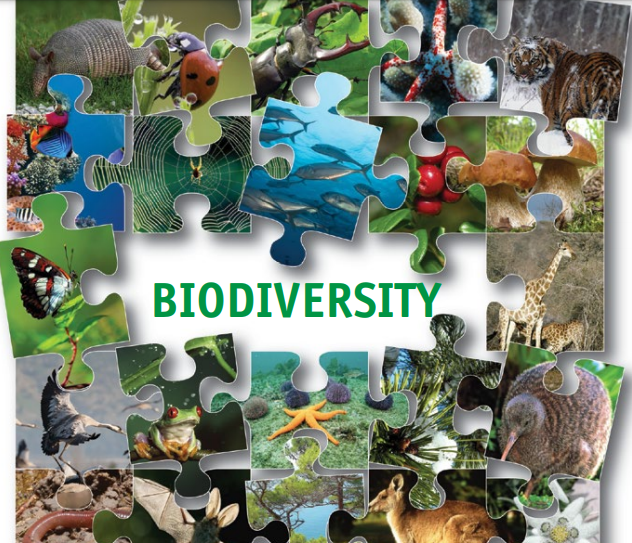

Scientists distinguish three main types of biodiversity:
• genetic (between organisms of the same species);
• species (between all of the living beings on the planet);
• landscape or ecosystem (between all the combinations of environments where organisms live)
What is genetic diversity? Take an example: it seems to us that 
all the geese in a flock of wild geese are the same. But in fact, they are all slightly different from one another. Remember how, in the remarkable story about Nils’ journey with the geese, each bird behaved differently. Of course, that is just a story, but it is basically true. One goose is quicker than the others to notice a fox creeping up on the sleeping flock across the ice; another remembers where to find a glade with lush grass beside a lake; and a third is better than the others at finding its way by the stars. So the whole flock benefits from the special skills of the individuals in it. And this doesn’t only apply to wild geese. Every kind of animal or plant needs to solve different tasks in order to survive, and they do it better if individual animals have different special abilities than if they are all exactly the same, like robots built on the same conveyor belt. Genetic diversity brings new species into existence. Biologists believe that differences in behaviour and appearance – between two bears, for example – can increase over generations. And after many years the great-great-great-grandchildren of these bears settle in different regions, begin to hunt for food in different ways and prepare for hibernation differently (or even give up hibernation). That is now two different species can come into existence – in this case, the Brown Bear and the Asian Black Bear.
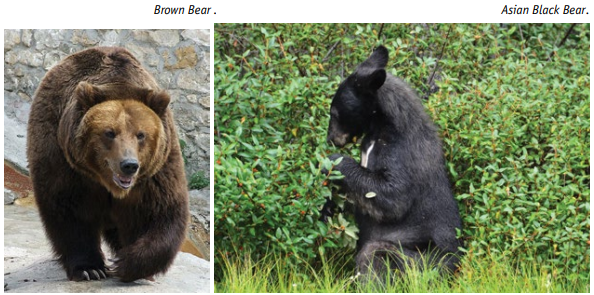
The difference between animals of different species and larger taxonomic groups, such as phylum or class, is clear to see: you don’t have to be a scientist to tell a dandelion from a plantain, a dragonfly from an ant, or a crow from a fox. But why are these and millions of other species of living beings so different?
Each species of organism on the planet has its own special role. In the African savanna the top part of the grass is eaten by zebras, the parts further down are taken by antelopes and wildebeest, while gazelles gnaw grass near the ground, and warthogs dig out the roots and tubers. So plant food is used in the most complete fashion, and the different kinds of animals are 
not in competition. This means that most of the animals living in a particular region are well-fed and healthy, and the whole ecosystem
will remain stable for a long time. All thanks to species diversity. Ecosystem diversity is easy for any attentive traveller to see, if he can distinguish an elder copse from a birch wood or a coral reef from mangroves. The countless variety of ecosystems in nature is like colourful scenery, against which the endless cycle of life unfolds. Except that the scenery itself plays a very important part in the cycle. Species diversity creates living conditions for huge numbers of organisms, providing them with sources of food and water, shelter, and migration routes. For example, some plants living in moist ravines can survive a severe forest fire. If excessive numbers of a certain type of insect threaten potato crops, they will be stopped by a zone where the soil freezes to a considerable depth in winter. So the greater the diversity of natural conditions, the higher the chances that various species will survive and that the ecosystem will be preserved.

Why is biodiversity so important?
Remember that until very recently (in historical terms) everything that people ate, used to build their homes, used as medicine, to make clothes, and for transport, was taken from nature. ‘Yes, but not anymore,’ you might say. But you would be wrong. For example, modern scientists still spend much time searching in rainforests to find natural raw ingredients for new medicines. Wild plant species are needed in order to create new crop varieties. And engineers have ‘borrowed’ many of their most original technical inventions from the kingdom of animals, plants, fungi and microorganisms. But that is not the most important role of biodiversity. What is most important is that biodiversity creates a habitat for all living beings, including us. What exactly does that mean? For many millions of years everything that grows, runs, swims, crawls and flies on our planet, has adapted to the composition of the Earth’s atmosphere. Changes to this ‘cocktail’ of gas might only be very slight. But even a slight reduction of the oxygen content in the air we breathe would make us and many other animals feel unwell. If oxygen levels fell even further, we would feel much worse. And what maintains the levels of oxygen in the atmosphere? Green plants!

All plants and animals, micro-organisms and fungi form a highly intricate and finely adjusted system. Imagine that you and your friends spent two whole years on a spaceship flying to Mars and back. Think of all the different parts, devices and other equipment that the spaceship would contain! Can you think of our planet being like that spaceship? Each of its ‘parts’ was created by millions of years of evolution, the action of each part was tuned to work in harmony with thousands of other parts. What would happen if an error by one of the crew or a meteorite damaged
several of the devices on the spaceship? You could replace them with other similar devices, at least for a while. But what if you then suffered some other space accident?
Biological diversity on Earth is quite similar. Every organism has an important job. One processes energy from the sun, another uses that processed energy to chase prey or escape from predators, a third breaks down dead wood or the remnants of dead animals, etc. Every one of them, from the vast baobab tree to the smallest lichen, from the mightiest whale to the lightest jellyfish are all-important components of life on planet Earth. And there are also organisms that we have yet to discover!
There may not be many of them, but they are also necessary. You might say: ‘There have been times in the history of life on the planet when whole groups of organisms became extinct. So the loss of one species is no disaster, or even of a dozen or a hundred…’ But stop! You are wrong! We don’t know how many losses our ‘spaceship’ can tolerate. Perhaps we have already overstepped the mark. In the short history of mankind, nature has irretrievably lost not a hundred or a thousand species, but many more!
Another important point is that biological diversity can be viewed as a measuring device that shows the sustainability and state of health of the natural world. If there are plenty of different species of living organisms, all playing their proper role, then the tropical rainforest, ocean reef or forest wetlands can continue to exist far into the future.
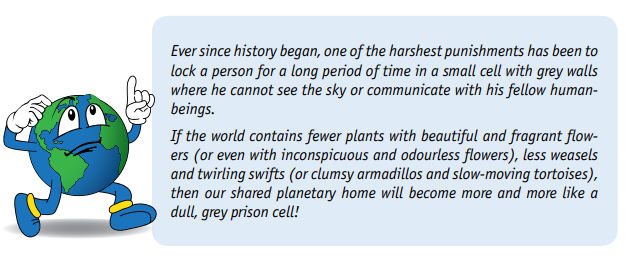
What are the threats to biodiversity?
Human activity poses the biggest threat to the undisturbed existence of wild nature in all its biodiversity. We cut down forests, plough up the steppe, burn savannas, drain swamps, hunt for game, catch fish, etc. Of course, we do not intend to destroy the natural world. Our aims are to feed the growing world population, to obtain wood to make things, to produce energy, to breed livestock, make room for our cities, roads, military sites and landfills, and much more.
Biodiversity is highly vulnerable to 
changes in natural conditions, whether they be changes of temperature, forest fires, melting of permafrost, drying out
of wetlands, fluctuations in the level of the ocean, etc. You already know why these changes are happening. One unusually hot summer is not a disaster. Over thousands of years of
evolution plant and animal life has adapted to short-term fluctuations in the climate and gradual changes in nature. But what does pose a threat to biodiversity is rapid and irreversible
changes in the environment, and particularly changes in the climate. Let’s try to figure out why.
Mass extinctions and climate change
Through the entire period of development of life on earth, which is known to science (three billion years, no less), there were several dozen periods of abrupt climate change that led to a marked reduction in biodiversity. Five of these stand out, and are commonly referred to as the ‘great extinctions’.
One of the most dramatic of them occurred about 250 million years ago. At that time the Earth was not yet populated by the plants and animals which are familiar to us now, but the diversity of life was already substantial. And then, quite suddenly in geological terms, in the space of a few million years, nearly all species of animals and plants disappeared (there were far fewer plant than animal species at the time, since life in the oceans and seas, consisting mainly of animals, was much richer than on land).

What mysterious causes led to the almost complete extinction of some species and the emergence of others? Scientists have strong reasons to suppose that the main causes were major changes on the planet’s surface, namely the drift of continents over the Earth’s crust (we already looked at this in previous sections). Continental drift changed the entire layout of the natural world as it then existed, including the position of mountain ranges and the system of ocean currents, and, of course, radically changed the Earth’s climate. After ancient eras when the world was cooling down, there came a time of climate warming. The climate became drier and seasonal fluctuations in temperature increased. Levels of oxygen in the surface atmosphere also changed. All of this led, as we have seen, to the large-scale replacement of certain species by new species of living beings.
Extinction of species was repeated, but never again on the scale of this first event. About 60 million years ago there was another fairly abrupt alteration of conditions on the planet, which led to the extinction of the last dinosaurs. This alteration was also accompanied by climate change, which speeded up the process of replacement of some animals and plants by other new species. Other groups of living beings, such as ammonites (sea molluscs similar in shape to
rams’ horns) and belemnites, whose fossils resemble arrowheads, followed the dinosaurs out of existence. Almost half of all sea creatures disappeared at that time, and how many disappeared on land is not precisely known, because the remains of land organisms are much less well preserved.

Cooling of the climate has been accompanied by the formation of ice caps at the Earth’s poles. The huge tracts of ice that now exist in Greenland and Antarctica can be seen in photographs of the Earth from space. How much water is needed to form such ice caps? A great deal. And where does it come from? It can only come from the ocean. When ice caps form, sea levels drop and living conditions for all of the organisms that live along coasts, in water and on land, change drastically. So, among its other effects, climate change affects biodiversity, and in the initial stages it affects it for the worst. Afterwards life on Earth gradually recovers, but it never reappears in its previous form! Millions of years are required for the recovery and species that have become extinct will never return. Do we want to face extinction as a species?
Which animals react most quickly to climate change?
Of course, everything that we have discussed up to now happened in the long distant past – a past so long distant that we cannot even imagine it. But how is climate change impacting in our time on wildlife in all its diversity? The impact of human activity and abrupt climate change has led to rates of species extinction across the planet that are many times greater than the rates that occur in nature. Small animals with short life cycles are particularly dependent on environmental conditions and therefore respond faster to climate change. Of course, large organisms also react, but, in their case, the effect take much longer to see. For our purposes as researchers we want to know
about events that are taking place today or will take place in the near future – events that we will live to see.
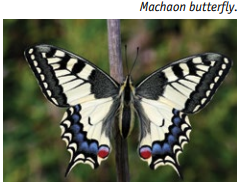
A modest but sustained rise of average temperatures by 1.5–2 °C in the mountains of Slovakia has led to unexpected consequences. Beautiful, warmth-loving butterflies of the swallowtail family – the Podalirius and Machaon – have spread beyond the forest-steppe zone, in which they lived, and begun to appear in cooler and damper meadowland. They have also begun to reproduce three times a year instead of twice, as before. Other butterflies, of the Araschnia genus, previously had different colouring depending on the season: brown in spring, black in summer and brown again in autumn. But they have now assumed black colouring at all times of the year.
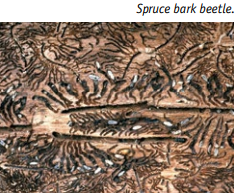
Also in the Slovak mountains, biologists have established two opposite tendencies in the life cycles of the spruce bark beetle and the winter moth caterpillar. The beetles have expanded their habitat area as temperatures have increased, while the voracious caterpillar, on the contrary, is now feeding less on its favourite trees. In both cases, there is a direct correlation between temperature changes and insect behaviour.
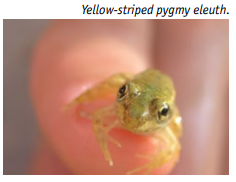
The yellow-striped pygmy eleuth is a small frog that inhabits tropical forests, where fluctuations in temperature and humidity during the day and through the year are small, but do occur. Scientists became interested in peculiarities of the relationship between the frog and a parasitic mold that grows on its body. It was found that the parasite is much less vulnerable to a change in environmental conditions than its host (the frog). So climate change make the parasite more dangerous to the frog, jeopardizing the entire population of the host species.
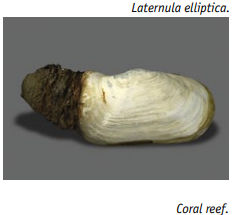
In the cold waters of the Southern Ocean, even the slightest increase in temperature leads to an increase in acidity and reduction of oxygen content. This has led to mass migrations by bivalvular molluscs of the species Laternula elliptica away from the danger zone. However, older molluscs (aged more than three years) lack the muscle strength to migrate and are perishing in large numbers. You may ask: can’t these creatures settle in new regions and restore population numbers? But it is not so easy: the species is only able to reproduce after the third year of life, when it loses mobility!
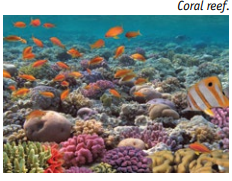
Corals have also been among the first to be affected by climate change. Corals are highly sensitive organisms. Water that is too warm or too cold, lack of light and excess impurities all act to slow down or completely stop the growth of corals. Coral polyps cannot move about and are very poorly adapted to environmental changes. They must live and die where they are born. The microalgae that absorb the energy of sunlight for coral polyps are very dependent on water temperature. At many places on Australia’s Great Barrier Reef, scientists are seeing the death of algae and bleaching of the coral, which occurs when the reef dies. Smoke from severe forest and peat fires in Indonesia often leads to atmospheric emissions of iron compounds, which cause rapid flowering of algae that produce substances that are toxic for corals.
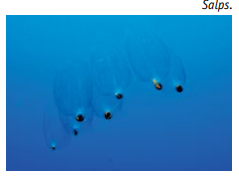
Warming in polar regions is reducing the area of seasonal sea ice, the underside of which is a breeding ground for microscopic ocean plants, called phytoplankton. Phytoplankton are at the beginning of a food chain, which includes krill, fish, penguins and other seabirds, seals and several sub-species of whales. If there is not enough ice, the phytoplankton cannot grow and breed in sufficient amounts. Krill cannot live in water that lacks sustenance, and their place is taken by translucent, jelly-like salps, which are ancient creatures. This causes an interruption of the food chain as hardly any animals eat salps, with the exception of a few species of fish and sea turtles. So whales cannot built up sufficient reserves of fat in the winter months, and other creatures also forsake waters that lack the food they need. Once again we see the complex interrelationships that exists in nature and are reflected in biodiversity.
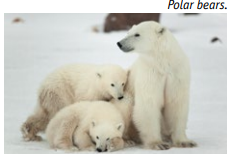 Shrinkage of the northern polar ice cap is the most visible sign of climate warming. Polar bears need ice for their migrations and in order to hunt for seals, and the ice is also vitally necessary for the seals themselves, as without it they have nowhere to rear their young. If the ice fields start to shrink more than is usual each summer, the seal population also shrinks and the hungry polar bears eat the whole carcass of the seals, which they catch, instead of devouring only the seal’s layer of fat. Previously the remains of the polar bear’s meal provided a feast for other inhabitants of the Arctic – the Arctic fox and numerous birds. But now there is nothing left over for them!
Shrinkage of the northern polar ice cap is the most visible sign of climate warming. Polar bears need ice for their migrations and in order to hunt for seals, and the ice is also vitally necessary for the seals themselves, as without it they have nowhere to rear their young. If the ice fields start to shrink more than is usual each summer, the seal population also shrinks and the hungry polar bears eat the whole carcass of the seals, which they catch, instead of devouring only the seal’s layer of fat. Previously the remains of the polar bear’s meal provided a feast for other inhabitants of the Arctic – the Arctic fox and numerous birds. But now there is nothing left over for them! 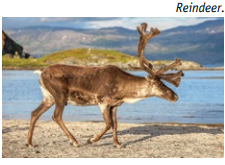
On the northern fringe of Eurasia the forest is slowly but surely advancing into the tundra at a rate of tens of kilometres each century as the climate becomes warmer.
This changes the habitat and food sources of numerous types of birds. Warm winters in the Arctic are also disastrous for both wild and domesticated reindeer, as thaws and rainfall in the winter cover the snow with a crust of ice, making it harder for the reindeer to find the lichens, which are their staple diet during the winter months.
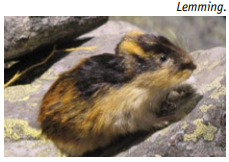
The lemming, the most numerous inhabitant of the tundra, is also suffering as a result of the warmer climate. The hole, where the lemming lives, is now flooded with water too early in the year, reducing the lemming population and forcing birds of prey and foxes to go hungry.In the southern hemisphere, on the Antarctic coast, which has the appearance of an ice desert with some rocky outcrops and very sparse vegetation, researchers
are suddenly finding abundant thickets of Antarctic hair grass, a small plant that previously grew only in small clumps between the stones, sheltering from the icy winds of the southern continent.
In the Daurian steppe of eastern Russia, between Lake Baikal and the Greater Khingan Mountains of Mongolia, scientists have noted that the climate is becoming more arid as a result of global warming. Lakes and small rivers are disappearing, forest belts are drying out and the vegetation on the steppe is burnt by the sun earlier in the year. The animal inhabitants of the steppe are doing what they can to adapt to the change. Larvae and fish spawn bury themselves deep in silt at the bottom of water courses. Birds migrate to other places, changing their flight paths and nesting sites. There is insufficient food for all of the local water birds, such as the cormorant, grey heron and herring gull. The swan goose
 no longer nests in the region. Wolves, fox, badgers and even cranes are moving away in search of more water. Bird of prey, which need plenty of water to digest their diet of meat, are also migrating to more suitable regions. The Tolai hare finds itself short of grass in the summertime, not only to feed on but also to hide from predators! The Tabargan marmot and Daurian ground squirrel, both of them indigenous to the area, are well-adapted to drought, but are finding life in the new conditions difficult, as they cannot move quickly enough to escape from
no longer nests in the region. Wolves, fox, badgers and even cranes are moving away in search of more water. Bird of prey, which need plenty of water to digest their diet of meat, are also migrating to more suitable regions. The Tolai hare finds itself short of grass in the summertime, not only to feed on but also to hide from predators! The Tabargan marmot and Daurian ground squirrel, both of them indigenous to the area, are well-adapted to drought, but are finding life in the new conditions difficult, as they cannot move quickly enough to escape from
grass fires, which are an increasingly frequent occurrence in the summertime. Burnt grass also means lack of winter forage for hoofed beasts, forcing large herds of antelope and gazelle to migrate from Mongolia to Russia. The few remaining watering places in the Daurian steppe are becoming overcrowded with animals in search of water, which increases the risk of disease. As the summers
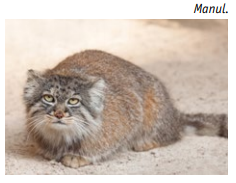
have become drier, the winters have experienced more snowfall, as a result of which the manul (a species of wild cat) cannot find food. The Daurian hedgehog is almost alone in benefiting from the change of climate: it needs more than five months of warmth for a successful life cycle, so it is expanding its presence in the new conditions.
National Parks: learning to preserve nature
What is a national park? It is a protected area that can be visited by tourists, but where human activity is limited by definite rules. National parks are usually created in places where there are many different landscapes (both typical and unique), rare or endangered animals and plants, and unique geological or water phenomena. National parks are visited by adults and children, who can learn there about global environmental issues. National parks can be used to create nurseries for the breeding of rare species of plants and animals, which can then be sent out into areas outside the park.
Does climate change affect national parks? Unfortunately, global climate change leads to fires, droughts, increase of the temperature in the atmosphere and many other phenomena that cannot be kept at bay simply by declaring an area to be a national park.
The conditions for freshwater flora and fauna in the Everglades park in Florida (USA) vary depending on the influx of salty sea water from the nearby Florida Bay, a process that is being influenced by climate change. Scientists and staff of protected areas understand that such processes threaten the very existence of national parks, and the US Environmental Protection Agency together with the National Park Service have therefore set up a special programme: ‘Climate Friendly Parks’. The programme acquaints park staff and visitors with the causes and consequences of climate change and explains what they themselves can do to help solve global problems associated with climate change


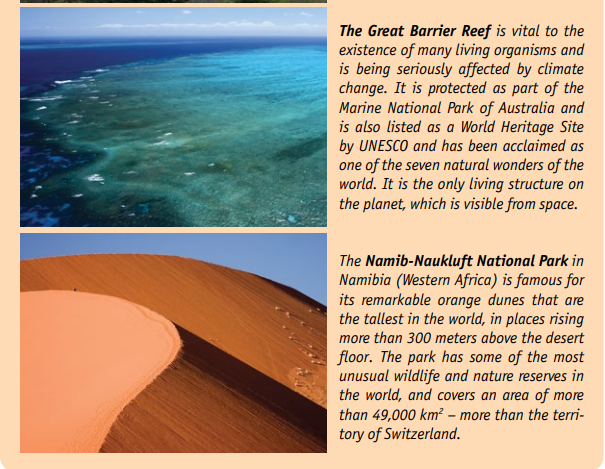
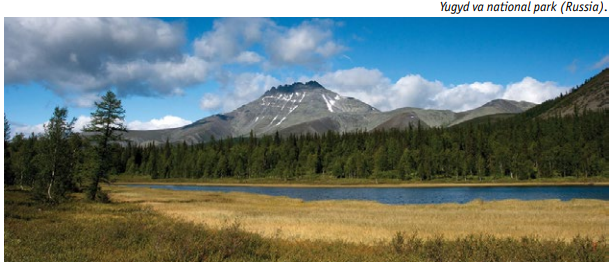
Wildlife reserves: nature without man
Wildlife (biosphere) reserves are places where scientists can monitor and record changes in the natural world. In a wildlife reserve it is forbidden even to even pick berries, mushrooms or to catch fish. Such places are ideal for restoring populations of endangered species, which can then be released into suitable areas outside the reserve.
Biosphere reserves are often created in places where nature is not subject to any substantial human influence. They are used to safeguard typical local ecosystems as well as rare species and communities of animals and plants. For example, the ecosystem to be protected in taiga regions would be that of the taiga, while in a tropical region it would be the tropical rainforest. Conservation of the natural environment in such areas has global importance.
Biosphere reserves exist on all of the world’s continents. You have probably seen films about such areas in Africa. It is thanks to such biosphere reserves that the diverse natural world of the African continent is being kept alive for us today.
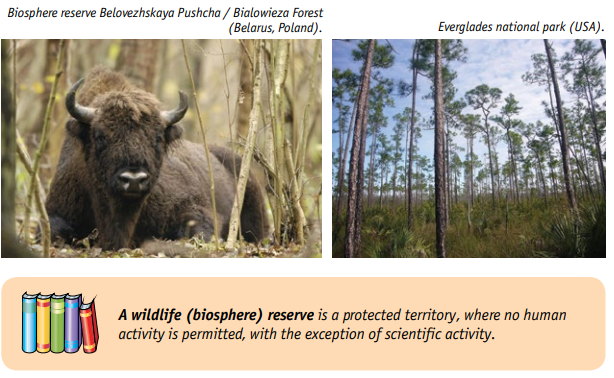

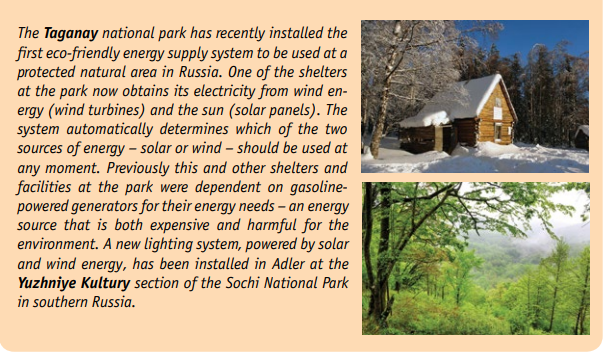
Wildlife sanctuaries and areas of outstanding natural importance
The point of wildlife sanctuaries is to protect, not the whole of the local natural environment, but only individual parts of it: for example, only plants or only animals, or perhaps some geological features (rocks or caves). So limitations on human activity in such sanctuaries only refer to activity that threatens the protected parts of the environment. Areas of outstanding natural importance are unique or typical natural areas and landmarks, which have special scientific, cultural, educational or health-related value. They may be lakes, trees, geological sites, or ancient parks. They are protected by prohibitions on types of human activity that could damage their integrity.
How do protected areas help to address the problems of climate change
What is the contribution of a national park (and any other protected area) in addressing climate change? The most significant contribution is the reduction of emissions of carbon dioxide into the atmosphere. For example, some parks encourage tourists to use public buses powered by alternative fuel instead of polluting private cars. Park employees themselves also use forms of transport that have minimal impact on the environment. Parks may use energy from the wind, sun or hot springs to operate the premises where they receive visitors. Maximum use is made
of natural lighting and LEDs, and power for offices is provided using solar panels. Tourists are offered souvenirs made from recycled materials, the park cafeteria serves dishes made from local products (products that do not have to be brought from a long way away, with resulting transport pollution, and that are made in an environmentally safe manner), and park premises are equipped with water-saving toilets. Information is provided, which teaches visitors how to behave in a way that is most environmentally efficient and least environmentally damaging.
Ecotourism: harmony between man and nature
Do you enjoy walking and other outdoor activities? If yes, then you and your friends will enjoy travelling and discovering new places. Maybe you will even become ecotourists.

What is the difference between tourists and ecotourists? What sets them apart most of all is their attitude towards the environment. Ecotourism is a recent concept, that arose when people began to understand how important that natural world is to us. There are different ways of relaxing outdoors. You can simply drive into the
forest or to the edge of a lake by car, switch on music at full volume, light a fire in the nicest place you can find, have plenty to eat and leave a pile of garbage behind you. But there are other tourists who are willing to climb to the top of a mountain just to see a wild animal, to find a rare plant, to listen to the birds singing, or to enjoy the sunset and the silence. Their main goal is to see and hear the natural world, which modern people so rarely witness. They don’t leave garbage – on the contrary, they often clear up other people’s garbage, and they make sure to obey all of the rules that are in place to protect the environment. Numbers of ecotourists are growing year by year!
Ecotourism gives people the opportunity to see the environment in its untouched, natural state, to understand how diverse it is, how vulnerable to human activity, and to ponder the question: ‘What can I do for my planet?’ Ecotourists study the laws of nature and do things that help to maintain and preserve it, they try to reduce their environmental impact to a minimum. What is more: ecotourism firms give a part of their income to support the protection and study of the environment.
Many outstanding natural environments are located in remote places, in rural areas where people are relatively poor. Or in areas such as the jungles of South America or mountain regions along the border between Northern Thailand, Myanmar and Laos, which are inhabited by indigenous people. Therefore ecotourists often learn not only about the natural world, but also about human culture. And ecotourism provides work and an additional source of income for the people who live in these regions.
So, ecotourism helps people to see the beauty and uniqueness of nature, to understand how everything in the world around them is connected, how many species of animals and plants live on our planet, and the extent to which the state of the environment depends on the actions of each person – teenagers and children as well as adults.
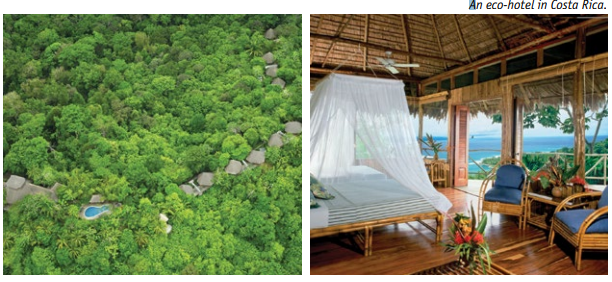
Ecotourism and climate change
The connection between climate change and ecotourism is not immediately obvious. But there is a strong connection, and many travel organizations are paying special attention to it today. What does it mean to travel? Above all it means moving from one place to another by plane or ocean liner, train, car or bus. All these forms of transport use fuel and therefore pollute the environment. The best forms of transport for ecotourism are bicycles, walking, horseback riding and rafting. You can build your tourist route in a way that reduces vehicle travel to a minimum and choose more environmentally friendly means of transport instead. This reduces emissions of greenhouse gas and harmful substances into the atmosphere.
Some people who get tired of the noise, traffic jams and other annoyances of city life, go further than eco-tourism: they move permanently to the countryside, where they learn to grow local fruits and vegetables and to eat environmentally friendly food. Typically, the owners of such mini-farms use alternative energy sources, refuse to use chemical fertilizers and pesticides, and make their own compost from organic waste. Such eco-farms exist in many countries, but are especially popular in rural areas of Europe, Australia, New Zealand, USA and Canada.
What is the Red Book and what is it for?
The Red Book is a list of rare and endangered species of animals, plants and fungi. The colour red reminds us of the risk to these species and the urgent need to protect and preserve them. Living organisms all over the planet, which are in need of protection, are listed in the International Red Book, the main copy of which is kept in the Swiss town of Morges. The book is published by the International Union for Nature Conservation (IUCN) and first appeared in 1963. This unusual book is designed more like a desk calendar than an ordinary book: as time passes, the situation of species already in the book changes and the names of new species of plants, animals and fungi are added to the book. So the Red Book is constantly changing and expanding.
For each species, which it contains, the Red Book provides information on the distribution, population numbers, habitat features, and measures required for conservation and many other details. The pages of the Book are marked with different colours. Pages describing extinct species are marked in black. These include, for example, the sea cow, the passenger pigeon and the dodo. Pages marked in red deal with endangered and very rare species (the Far- Eastern leopard, the Amur tiger, the snow leopard and the European bison). Animals, whose populations
numbers are rapidly decreasing are listed on pages marked yellow (the polar bear, pink seagull, goitered gazelle). Animals and plants, which are rarely found in the wild are recorded on white pages. Species that have not been sufficiently studied because they live in remote places are recorded in grey, while the most encouragement is to be taken from green pages, which record species that people have succeeded in saving from extinction (they include the Eurasian beaver and the Eurasian elk).
Each country and region in the world also create their own lists of rare and protected species.
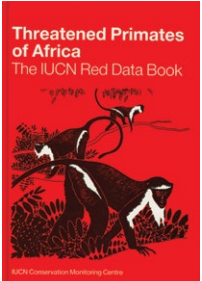
Before a particular species is included in the Red Book, scientists carry out intensive studies of the flora, fauna and fungi in relevant areas, find out the causes which threaten the species, describe their habitats and decide how they should be preserved. The Red Book does not only contain rare and endemic species (species found only in a specific territory), but a whole range of flowering, edible and medicinal plants. Animals and plants may need to be protected for two groups of reasons: direct and indirect. Direct reasons for protection exist when people by their actions are destroying the animals and plants, through hunting, gathering medicinal plants,
fishing or other collection of aquatic organisms. Indirect reasons relate to change of habitat, including that which is caused by global climate change. Such indirect reasons may include difficult acclimatization to climate change, the introduction of new species of plants (when the ‘newcomers’ displace native species, for any of various reasons) and the destruction of the plants that are a source of food for
animals, etc.

